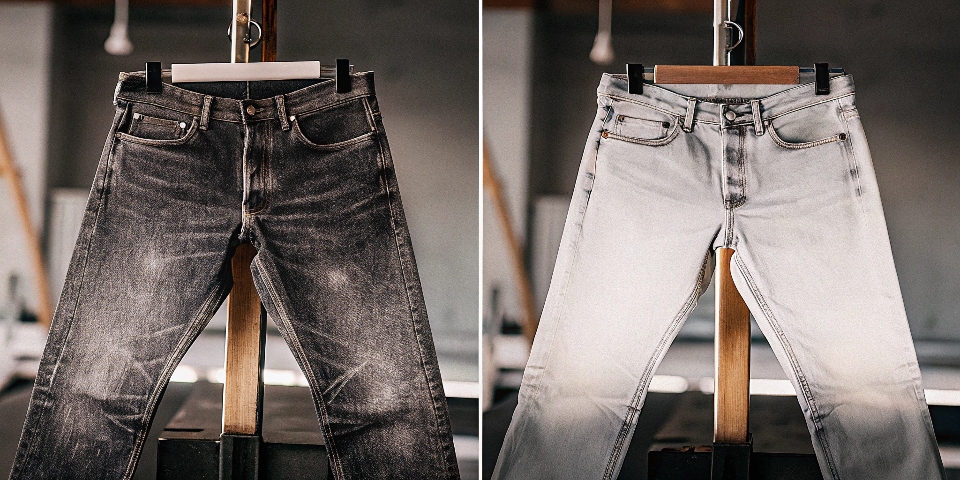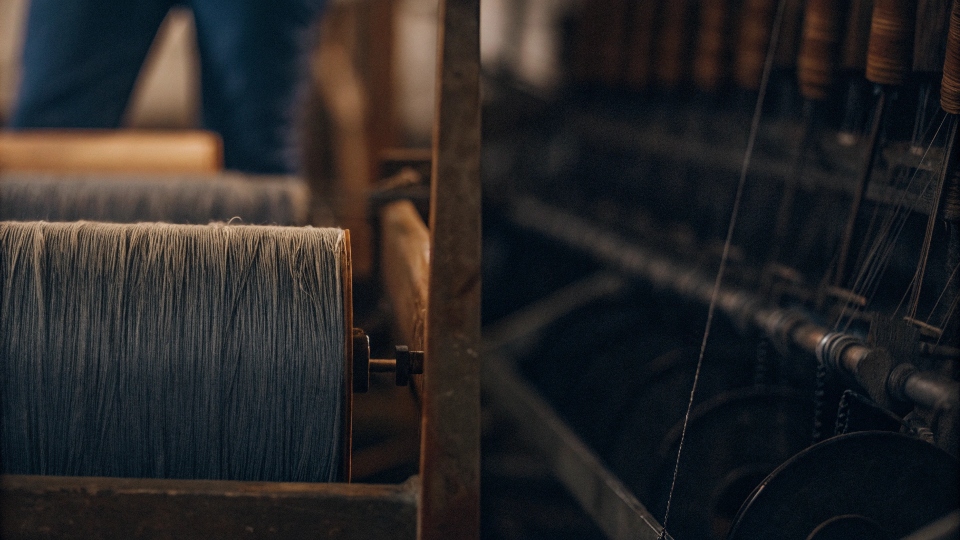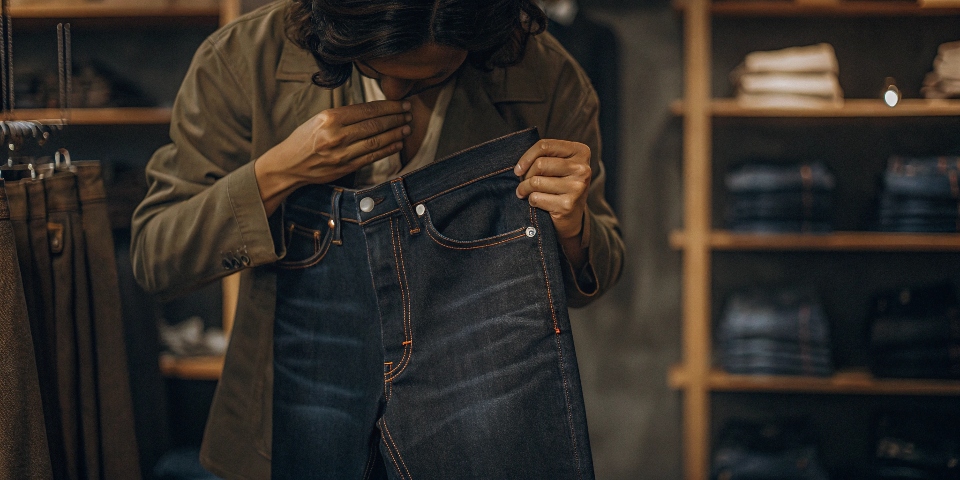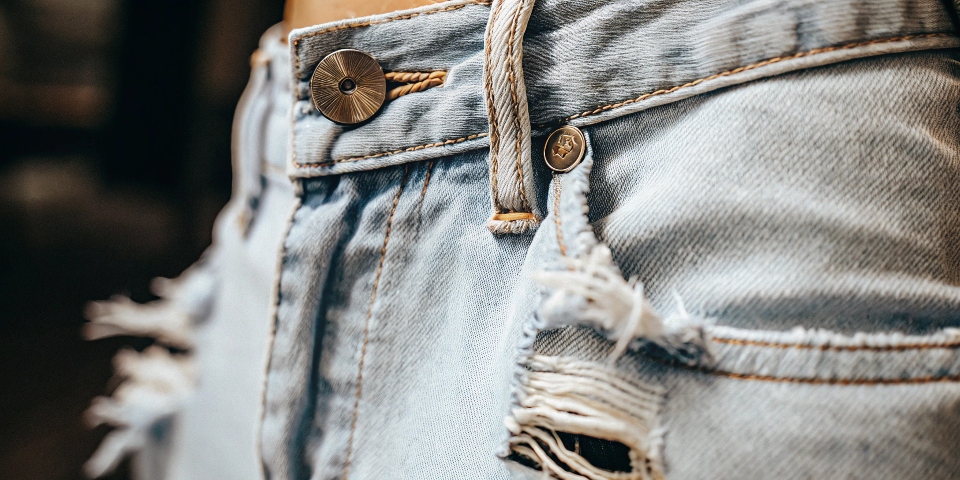You stand in a store surrounded by jeans, all looking similar. Some cost $30, others $300, but you can't see the difference, leaving you unsure if you're getting a great deal or a bad product.
High-quality denim feels substantial and has a rich, slightly uneven color from natural dyes. Low-quality denim often has a sharp chemical smell, feels flimsy, and features weak stitching and hardware, revealing its poor construction.
After two decades running the DiZNEW denim factory, my hands can tell the quality of a fabric in seconds. This isn't magic; it's just knowing what to look for.
For a top designer like Dean, these details are everything. He needs to know the fabric will not only look good on day one but will wear beautifully for years. I want to share a few of these insider secrets with you, so you can spot the difference yourself.
Are there different qualities of denim?
You assume all denim is more or less the same tough cotton fabric. This makes it hard to justify spending more, as you feel you're just paying for a brand name.
Yes, there are huge differences in denim quality. The quality is determined by the "genes" of the fabric—the type of cotton used—and the "upbringing"—the dyeing and construction process. These factors create vastly different products.
The difference between premium and cheap denim starts at the very beginning, with the cotton. My notes describe this as the fabric's "genetic difference."
It Starts with the Cotton Fiber
High-end denim often uses superior long-staple cotton1, like Supima from the USA or Zimbabwean cotton. The fibers from these plants are about 30% longer than standard cotton.
When we weave this at the factory, the resulting fabric is stronger, softer, and has a unique feel I can only describe as a "matte velvet." If you've ever felt a pair of Levi's Vintage Clothing jeans, you know this texture.
In contrast, many factories cut costs by using short-staple cotton or mixing it into their fabrics. This creates a weaker yarn.
The result is a pair of jeans that might feel okay at first but starts pilling and losing its shape after just a few wears. A quality pair made from long-staple cotton will still feel sturdy and strong six months later.
The Art of Dyeing
The dyeing process is just as important. Premium Japanese mills like Kuroki, which we respect immensely, use natural indigo2 and a painstaking process.
They might dip the yarn up to 13 times. This creates a deep, complex color with a subtle gradient effect, almost like ink spreading on paper. When it fades, you get beautiful, natural "whiskers." The cheaper, mass-produced method uses chemical dyes and maybe three quick dips.
This results in a flat, dead color that looks like paint. After a couple of washes, it fades into a boring, uniform "blue rag" with no character.
How can you tell if denim is high quality?
You want to make a smart purchase but feel lost without an expert by your side. You need simple, practical tests you can do right there in the store.
Trust your senses. High-quality denim has a substantial feel, even stitching, solid hardware, and a faint, natural smell. It feels like a garment built to last, not one made to be cheap.
You don't need to be an expert to spot quality. You just need to know what to look for. Here's a simple checklist I use.
The 3-Second Smell Test
This is my fastest trick. Roll up the pant leg and take a sniff of the inside. My notes are very clear on this:
- ✅ High-Quality Jeans3: Will have a faint, slightly earthy or plant-like smell. This is the natural scent of indigo dye. It smells like an old, traditional cloth workshop.
- ❌ Low-Quality Jeans4: Will often have a sharp, pungent chemical or metallic smell. This is a dead giveaway that a cheap, fast dyeing process was used. Trust your nose; it can spot poor quality instantly.
Check the Details
After the smell test, use your eyes and hands. A well-made garment shows its quality in the small things we focus on at the factory.
| Feature | High-Quality Sign | Low-Quality Sign |
|---|---|---|
| Stitching | Dense, straight, and consistent stitches. No loose threads. | Uneven, sparse stitches. Many messy, uncut threads. |
| Fabric Feel | Substantial, strong, with a rich texture. Stiff but smooth. | Flimsy, thin, or unnaturally soft from chemical softeners. |
| Hardware | Heavy, solid buttons and rivets. A smooth, sturdy zipper. | Lightweight, tinny buttons. A zipper that feels gritty or snags. |
| Color Depth | Rich color with subtle variations. Looks deep and complex. | Flat, uniform, one-dimensional color that looks "painted on". |
How to tell cheap denim?
You're on a budget but still want something that will last. You need to know the specific red flags that scream "this will fall apart in a month."
Cheap denim reveals itself quickly. The biggest red flags are a strong chemical smell, flimsy and thin fabric, messy stitching with lots of loose threads, and lightweight hardware that feels like plastic.
Spotting cheap denim5 is about recognizing the corners that were cut during manufacturing.
From my experience, these shortcuts are easy to see if you know where to look. The first and most obvious sign is the chemical smell I mentioned before. If it smells bad, the dyeing process was cheap and rushed, and the color will not last.
Next, just hold it. Does it feel heavy and durable, or does it feel weak and thin? Quality denim has a reassuring weight to it. Cheap denim often feels light and flimsy, a sign that less cotton was used to save money.
Then, look closely at the construction. On a cheap pair, you'll see sloppy workmanship everywhere. The stitches will be uneven, and you'll find lots of loose threads, especially around the buttonholes and inside the pockets. Check the hardware. Press on the main button and rivets.
If they feel light, hollow, or like they could bend easily, it's a sign of a cheap component that could fail. A quality garment will have solid, heavy-duty hardware that feels like it will last a lifetime. These are not just aesthetic details; they are direct indicators of the overall care and cost that went into making the jeans.
What is the difference between low-rise and high rise denim?
You see terms like "low-rise" and "high-rise" on tags. You're not sure which is which, or how they will actually look and feel on your body.
The "rise" is the distance from the crotch seam to the top of the waistband. High-rise sits at or above your natural waist, while low-rise sits down on your hips.
While fabric quality determines how long your jeans will last, the rise determines how they fit. This is a critical measurement that dictates the entire style and silhouette of the jean.
Understanding the Rise
- High-Rise6: This style typically sits at or even above your belly button. It cinches you at your natural waist. This fit became popular in the 70s and 80s and is known for creating an hourglass shape and making your legs look longer. It's fantastic for tucking in shirts.
- Low-Rise: This style sits very low, several inches below your belly button, resting on your hips. It became extremely popular in the early 2000s and creates a very casual, relaxed aesthetic. It focuses attention on the hips and torso.
- Mid-Rise7: This is the most common and often considered the most versatile style. It sits comfortably between the hips and the navel, usually just below the belly button. It offers a great balance of comfort and coverage and works well for most body types and occasions.
| Rise Style | Where It Sits | Fashion Effect |
|---|---|---|
| High-Rise | At or above the natural waist/navel | Defines the waist, elongates legs, vintage feel |
| Mid-Rise | Below the navel, above the hips | Balanced, comfortable, versatile for most body types |
| Low-Rise | Low on the hips | Casual, relaxed, emphasizes the torso, Y2K aesthetic |
Conclusion
To find great jeans, inspect the fabric, stitching, and hardware. Trust your senses—especially smell—to identify quality. Choose the rise that makes you feel most comfortable and confident.
-
Explore the advantages of long-staple cotton for denim to understand why it enhances quality and durability. ↩
-
Discover the significance of natural indigo in dyeing processes and how it contributes to the uniqueness of premium denim. ↩
-
Discover the essential traits of high-quality jeans to make informed purchasing decisions. ↩
-
Learn how to spot low-quality jeans to avoid wasting money on inferior products. ↩
-
Understanding the signs of cheap denim can help you make informed purchasing decisions and avoid low-quality products. ↩
-
Explore the advantages of high-rise jeans, including their flattering fit and style benefits for various body types. ↩
-
Discover why mid-rise jeans are favored for their comfort and adaptability across different occasions and body shapes. ↩











